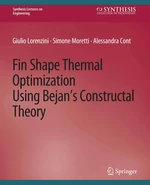The book contains research results obtained by applying Bejan's Constructal Theory to the study and therefore the optimization of fins, focusing on T-shaped and Y-shaped ones. Heat transfer from finned surfaces is an example of combined heat transfer natural or forced convection on the external parts of the fin, and conducting along the fin. Fin's heat exchange is rather complex, because of variation of both temperature along the fin and convective heat transfer coefficient. Furthermore possible presence of more fins invested by the same fluid flow has to be considered.Classical fin theory tried to reduce the coupled heat transfer problem to a one-dimensional problem by defining an average temperature of the fin and writing equations using this parameter. However, it was shown that this approach cannot be used because of the effects of two-dimensional heat transfer, especially in the presence of short fins. CFD codes offer the possibility to consider bi-dimensional (and more generally, three-dimensional) effects and then a more real approach to the physic phenomena of finned surface's heat exchange.A commercial CFD code was used to analyse the case of heat exchange in presence of T-shaped fins, following an approach suggested by Bejan's Constructal Theory. The comparative results showed a significant agreement with previous research taken as a reference, and this result allows for the application of this approach to a wider range of systems. T-shaped optimized fin geometry is the starting point for further research.Starting from the optimal results (T-shape optimized fins), we show the trend of the assessment parameter (the dimensionless conductance) in function of the angle a between the two horizontal arms of the fin. A value for a, 90°
Price history
Jan 31, 2023
€57.92

